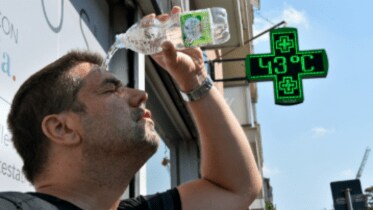What are the stages of heat stress, and when should one seek medical attention? Dr Rakesh Gupta, senior consultant, internal medicine, Indraprastha Apollo Hospitals, says: “Heat stress can progress through several stages, and it is crucial to recognise the symptoms and seek medical attention when necessary.”
The first stage is heat cramps, characterised by painful muscle spasms, usually in the legs or abdomen, caused by the loss of electrolytes and fluids through excessive sweating. If heat cramps occur, it is essential to rest in a cool environment and replenish fluids and electrolytes. The next stage is heat exhaustion, which involves symptoms such as heavy sweating, dizziness, nausea, headache and rapid heartbeat. Immediate cooling measures, such as moving to a shaded or air-conditioned area and drinking fluids, should be taken.
Heat stroke, the most severe stage, is a life-threatening eme-rgency that requires immediate medical intervention. Symptoms include a body temperature above 104°F (40°C), hot and dry skin, confusion, loss of consciousness, and possible seizures. Heat stroke can lead to organ failure and brain damage, if not treated promptly.
How many hours can an individual stay under the intense sun before being adversely affected?
There is no definitive time frame that applies to everyone, as factors such as age, physical condition, hydration levels, acclimatisation to hot environments, and the intensity of the sun’s rays play a significant role. Generally, healthy adults can tolerate exposure to intense sun for a few hours, but prolonged exposure without adequate precautions can lead to adverse effects.
What should be the emergency treatment given to anyone suffering heat adversity?
First and foremost, move the person to a cool, shaded area or an air-conditioned environment. If heat stroke is suspected (body temperature above 104°F/40°C, hot and dry skin, confusion, or unconsciousness), immediate cooling measures should be implemented. These include removing excess clothing, applying cool water or ice packs to the armpits, groin and neck areas, and fanning the person to promote evaporative cooling. If the person is conscious and able to swallow, provide cool fluids to drink, such as water or sports drinks, to aid in rehydration. However, avoid offering fluids if the person is vomiting or showing signs of altered consciousness.
Secondly, call for emergency medical assistance. While waiting for professional help, continue cooling efforts and monitor the person’s vital signs, such as body temperature, pulse and breathing rate. If the person becomes unresponsive, be prepared to perform CPR, if necessary. Heat-related illnesses can progress rapidly and prompt medical attention is crucial for proper treatment.
Are any category of people particularly vulnerable?
Older adults: As people age, their ability to regulate body temperature and sense thirst diminishes, making them more susceptible to dehydration and heat-related problems.
Infants and young children: Their bodies have a larger surface area relative to their weight, and they may have difficulty regulating their body temperature. They may not also be able to communicate their discomfort effectively.
People with chronic medical conditions: Individuals with conditions such as heart disease, lung disease, diabetes, obesity or those taking certain medications (diuretics, anticholinergics, antidepressants) may have impaired heat regulation mechanisms.
People with limited mobility: Those who are bedridden, have disabilities or are unable to care for themselves may have difficulty accessing cool environments or hydrating properly.
Athletes and outdoor workers: Individuals who engage in strenuous physical activities or work outdoors for extended periods are at a higher risk due to increased heat production and potential dehydration.
People without access to air conditioning: Prolonged exposure to high temperatures without adequate cooling can lead to heat stress, especially during heat waves or in areas with high humidity.
What are the extreme and serious consequences?
Heat stress, if left unaddressed, can lead to extreme and serious consequences that can be life-threatening. The most severe form of heat stress is heat stroke, which is a medical emergency. In cases of heat stroke, the body’s temperature regulation system fails, and the core body temperature rises to dangerous levels, typically above 104°F (40°C). This can result in widespread cellular damage and organ dysfunction. If left untreated, heat stroke can cause severe complications such as brain damage, kidney failure, muscle breakdown (rhabdomyolysis), and even death.
Other serious consequences of heat stress include heat exhaustion, which can cause dehydration, electrolyte imbalances and cardiovascular strain.
